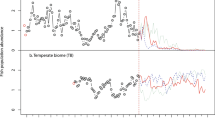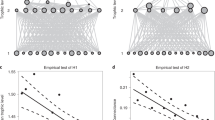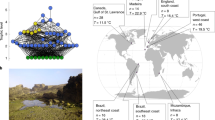Abstract
Evaluating the effects of climate variation on ecosystems is of paramount importance for our ability to forecast and mitigate the consequences of global change. However, the ways in which complex food webs respond to climate variations remain poorly understood. Here, we use long-term time series to investigate the effects of temperature variation on the intraguild-predation (IGP) system of Windermere (UK), a lake where pike (Esox lucius, top predator) feed on small-sized perch (Perca fluviatilis) but compete with large-sized perch for the same food sources. Spectral analyses of time series reveal that pike recruitment dynamics are temperature controlled. In 1976, expansion of a size-truncating perch pathogen into the lake severely impacted large perch and favoured pike as the IGP-dominant species. This pathogen-induced regime shift to a pike-dominated IGP apparently triggered a temperature-controlled trophic cascade passing through pike down to dissolved nutrients. In simple food chains, warming is predicted to strengthen top–down control by accelerating metabolic rates in ectothermic consumers, while pathogens of top consumers are predicted to dampen this top–down control. In contrast, the local IGP structure in Windermere made warming and pathogens synergistic in their top–down effects on ecosystem functioning. More generally, our results point to top predators as major mediators of community response to global change, and show that size-selective agents (e.g. pathogens, fishers or hunters) may change the topological architecture of food webs and alter whole ecosystem sensitivity to climate variation.








Similar content being viewed by others
References
Abrams PA (2011) Simple life-history omnivory: responses to enrichment and harvesting in systems with intraguild predation. Am Nat 178:305–319. doi:10.1086/661243
Ajmal M, Hobbs BC (1967) Causes and effects of Columnaris-type diseases in fish. Nature 215:142–143. doi:10.1038/215142a0
Allen MR, Robertson AW (1996) Distinguishing modulated oscillations from coloured noise in multivariate datasets. Clim Dyn 12:775–784. doi:10.1007/s003820050142
Allen MR, Smith LA (1996) Monte Carlo SSA: detecting irregular oscillations in the presence of colored noise. J Clim 9:3373–3404. doi:10.1175/1520-0442(1996)009<3373:MCSDIO>2.0.CO;2
Altizer S, Dobson A, Hosseini P et al (2006) Seasonality and the dynamics of infectious diseases. Ecol Lett 9:467–484. doi:10.1111/j.1461-0248.2005.00879.x
Angilletta MJ, Dunham AE (2003) The temperature-size rule in ectotherms: simple evolutionary explanations may not be general. Am Nat 162:332–342. doi:10.1086/377187
Bjørnstad ON, Nisbet RM, Fromentin J-M (2004) Trends and cohort resonant effects in age-structured populations. J Anim Ecol 73:1157–1167. doi:10.1111/j.0021-8790.2004.00888.x
Bodaly RA, Ward RD, Mills CA (1989) A genetic stock study of perch, Perca fluviatilis L., in Windermere. J Fish Biol 34:965–967. doi:10.1111/j.1095-8649.1989.tb03380.x
Botsford LW, Holland MD, Field JC, Hastings A (2014) Cohort resonance: a significant component of fluctuations in recruitment, egg production, and catch of fished populations. ICES J Mar Sci 71:2158–2170. doi:10.1093/icesjms/fsu063
Bucke D, Cawley GD, Craig JF et al (1979) Further studies of an epizootic of perch Perca fluviatilis L., of uncertain aetiology. J Fish Dis 2:297–311. doi:10.1111/j.1365-2761.1979.tb00172.x
Cazelles B, Chavez M, Constantin de Magny G et al (2007) Time-dependent spectral analysis of epidemiological time-series with wavelets. J R Soc Interface 4:625–636. doi:10.1098/rsif.2007.0212
Cazelles B, Chavez M, Berteaux D et al (2008) Wavelet analysis of ecological time series. Oecologia 156:287–304. doi:10.1007/s00442-008-0993-2
Cazelles B, Cazelles K, Chavez M (2014) Wavelet analysis in ecology and epidemiology: impact of statistical tests. J R Soc Interface 11:20130585. doi:10.1098/rsif.2013.0585
De Roos AM, Schellekens T, Van Kooten T, Persson L (2008) Stage-specific predator species help each other to persist while competing for a single prey. Proc Natl Acad Sci 105:13930–13935
Edeline E, Ben Ari T, Vøllestad LA et al (2008) Antagonistic selection from predators and pathogens alters food-web structure. Proc Natl Acad Sci 105:19792–19796
Edeline E, Lacroix G, Delire C et al (2013) Ecological emergence of thermal clines in body size. Glob Change Biol 19:3062–3068. doi:10.1111/gcb.12299
Feliks Y, Ghil M, Simonnet E (2004) Low-frequency variability in the midlatitude atmosphere induced by an oceanic thermal front. J Atmos Sci 61:961–981. doi:10.1175/1520-0469(2004)061<0961:LVITMA>2.0.CO;2
Feliks Y, Ghil M, Robertson AW (2010) Oscillatory climate modes in the eastern Mediterranean and their synchronization with the North Atlantic Oscillation. J Clim 23:4060–4079. doi:10.1175/2010JCLI3181.1
Feliks Y, Groth A, Robertson AW, Ghil M (2013) Oscillatory climate modes in the Indian monsoon, North Atlantic, and tropical Pacific. J Clim 26:9528–9544. doi:10.1175/JCLI-D-13-00105.1
George DG, Harris GP (1985) The effect of climate on long-term changes in the crustacean zooplankton biomass of Windermere, UK. Nature 316:536–539. doi:10.1038/316536a0
Ghil M, Vautard R (1991) Interdecadal oscillations and the warming trend in global temperature time series. Nature 350:324–327
Ghil M, Allen MR, Dettinger MD et al (2002) Advanced spectral methods for climatic time series. Rev Geophys 40:1–41. doi:10.1029/2000RG000092
Griffiths D, Kirkwood RC (1995) Seasonal variation in growth, mortality and fat stores of roach and perch in Lough Neagh, Northern Ireland. J Fish Biol 47:537–554. doi:10.1111/j.1095-8649.1995.tb01920.x
Groth A, Ghil M (2011) Multivariate singular spectrum analysis and the road to phase synchronization. Phys Rev E 84:036206
Groth A, Ghil M (2015) Monte Carlo singular spectrum analysis (SSA) revisited: detecting oscillator clusters in multivariate datasets. J Clim 28:7873–7893. doi:10.1175/JCLI-D-15-0100.1
Gurney WSC, Nisbet RM (1985) Fluctuation periodicity, generation separation, and the expression of larval competition. Theor Popul Biol 28:150–180. doi:10.1016/0040-5809(85)90026-7
Harvell CD (2002) Climate warming and disease risks for terrestrial and marine biota. Science 296:2158–2162. doi:10.1126/science.1063699
Hatcher MJ, Dick JTA, Dunn AM (2006) How parasites affect interactions between competitors and predators. Ecol Lett 9:1253–1271. doi:10.1111/j.1461-0248.2006.00964.x
Haugen TO, Winfield IJ, Vøllestad LA et al (2006) The ideal free pike: 50 years of fitness-maximizing dispersal in Windermere. Proc R Soc B Biol Sci 273:2917–2924. doi:10.1098/rspb.2006.3659
Haugen TO, Winfield IJ, Vøllestad LA et al (2007) Density dependence and density independence in the demography and dispersal of pike over four decades. Ecol Monogr 77:483–502
Hidalgo M, Rouyer T, Molinero JC et al (2011) Synergistic effects of fishing-induced demographic changes and climate variation on fish population dynamics. Mar Ecol Prog Ser 426:1–12. doi:10.3354/meps09077
Holdo RM, Sinclair ARE, Dobson AP et al (2009) A disease-mediated trophic cascade in the Serengeti and its implications for ecosystem C. PLoS Biol 7:e1000210. doi:10.1371/journal.pbio.1000210
Holt RD, Polis GA (1997) A theoretical framework for intraguild predation. Am Nat 149:745–764. doi:10.2307/2463547
Hudson PJ, Dobson AP, Lafferty KD (2006) Is a healthy ecosystem one that is rich in parasites? Trends Ecol Evol 21:381–385. doi:10.1016/j.tree.2006.04.007
IPCC (2014) Climate change 2014: synthesis report. Contribution of Working Groups I, II and III to the fifth assessment report of the Intergovernmental Panel on Climate Change. Intergovernmental Panel on Climate Change, Geneva
Langangen Ø, Edeline E, Ohlberger J et al (2011) Six decades of pike and perch population dynamics in Windermere. Fish Res 109:131–139. doi:10.1016/j.fishres.2011.01.029
Möllmann C, Diekmann R (2012) Marine ecosystem regime shifts induced by climate and overfishing: a review for the northern hemisphere. Adv Ecol Res 47:303–347. doi:10.1016/B978-0-12-398315-2.00004-1
O’Connor MI, Piehler MF, Leech DM et al (2009) Warming and resource availability shift food web structure and metabolism. PLoS Biol 7:e1000178. doi:10.1371/journal.pbio.1000178
Ohlberger J, Edeline E, Vøllestad LA et al (2011a) Temperature-driven regime shifts in the dynamics of size-structured populations. Am Nat 177:211–223. doi:10.1086/657925
Ohlberger J, Langangen Ø, Edeline E et al (2011b) Stage-specific biomass overcompensation by juveniles in response to increased adult mortality in a wild fish population. Ecology 92:2175–2182
Ohlberger J, Langangen Ø, Edeline E et al (2011c) Pathogen-induced rapid evolution in a vertebrate life-history trait. Proc R Soc B Biol Sci 278:35–41. doi:10.1098/rspb.2010.0960
Oksanen L, Fretwell SD, Arruda J, Niemela P (1981) Exploitation ecosystems in gradients of primary productivity. Am Nat 118:240–261. doi:10.2307/2460513
Paxton CGM, Winfield IJ, Fletcher JM et al (2004) Biotic and abiotic influences on the recruitment of male perch in Windermere, UK. J Fish Biol 65:1622–1642. doi:10.1111/j.0022-1112.2004.00573.x
Paxton CGM, Winfield IJ, Fletcher JM et al (2009) Investigation of first year biotic and abiotic influences on the recruitment of pike Esox lucius over 48 years in Windermere, UK. J Fish Biol 74:2279–2298. doi:10.1111/j.1095-8649.2009.02235.x
Petchey OL, McPhearson PT, Casey TM, Morin PJ (1999) Environmental warming alters food-web structure and ecosystem function. Nature 402:69–72. doi:10.1038/47023
Plaut G, Vautard R (1994) Spells of low-frequency oscillations and weather regimes in the northern hemisphere. J Atmos Sci 51:210–236. doi:10.1175/1520-0469(1994)051<0210:SOLFOA>2.0.CO;2
Plaut G, Ghil M, Vautard R (1995) Interannual and interdecadal variability in 335 years of central England temperatures. Science 268:710–713. doi:10.1126/science.268.5211.710
Pokorná L, Huth R (2015) Climate impacts of the NAO are sensitive to how the NAO is defined. Theor Appl Climatol 119:639–652. doi:10.1007/s00704-014-1116-0
Rall BC, Vucic-Pestic O, Ehnes RB et al (2009) Temperature, predator-prey interaction strength and population stability. Glob Change Biol 16:2145–2157. doi:10.1111/j.1365-2486.2009.02124.x
Rouyer T, Fromentin JM, Stenseth NC, Cazelles B (2008) Analysing multiple time series and extending significance testing in wavelet analysis. Mar Ecol Prog Ser 359:11–23. doi:10.3354/meps07330
Shurin JB, Clasen JL, Greig HS et al (2012) Warming shifts top–down and bottom-up control of pond food web structure and function. Philos Trans R Soc B Biol Sci 367:3008–3017. doi:10.1098/rstb.2012.0243
Thackeray SJ, Henrys PA, Jones ID, Feuchtmayr H (2012) Eight decades of phenological change for a freshwater cladoceran: what are the consequences of our definition of seasonal timing? Freshwater Biol 57:345–359. doi:10.1111/j.1365-2427.2011.02614.x
van de Wolfshaar KE, de Roos AM, Persson L (2008) Population feedback after successful invasion leads to ecological suicide in seasonal environments. Ecology 89:259–268. doi:10.1890/06-2058.1
Vasseur DA, McCann KS (2005) A mechanistic approach for modeling temperature-dependent consumer-resource dynamics. Am Nat 166:184–198
Vautard R, Ghil M (1989) Singular spectrum analysis in nonlinear dynamics, with applications to paleoclimatic time series. Phys Nonlinear Phenom 35:395–424
Vindenes Y, Edeline E, Ohlberger J et al (2014) Effects of climate change on trait-based dynamics of a top predator in freshwater ecosystems. Am Nat 183:243–256. doi:10.1086/674610
Voigt W, Perner J, Davis AJ et al (2003) Trophic levels are differentially sensitive to climate. Ecology 84:2444–2453. doi:10.1890/02-0266
Vucic-Pestic O, Ehnes RB, Rall BC, Brose U (2011) Warming up the system: higher predator feeding rates but lower energetic efficiencies. Glob Change Biol 17:1301–1310. doi:10.1111/j.1365-2486.2010.02329.x
Wilmers CC, Post E, Peterson RO, Vucetich JA (2006) Predator disease out-break modulates top–down, bottom-up and climatic effects on herbivore population dynamics. Ecol Lett 9:383–389. doi:10.1111/j.1461-0248.2006.00890.x
Winfield IJ, Fletcher JM, Ben James J (2012) Long-term changes in the diet of pike (Esox lucius), the top aquatic predator in a changing Windermere. Freshwater Biol 57:373–383. doi:10.1111/j.1365-2427.2011.02607.x
Yvon-Durocher G, Jones JI, Trimmer M et al (2010) Warming alters the metabolic balance of ecosystems. Philos Trans R Soc B Biol Sci 365:2117–2126. doi:10.1098/rstb.2010.0038
Acknowledgments
We thank Janice Fletcher, Ben James and other colleagues for undertaking the field and laboratory work of the Windermere fish monitoring programme and Lorenzo Ciannelli for useful discussions. We are also grateful to the Freshwater Biological Association who collected the data at the beginning of the time series. It is a pleasure to thank two anonymous reviewers for their detailed and constructive comments. The Natural Environment Research Council of the UK and the Norwegian Research Council supported part of this work. E. E. and D. C. received financial support from the French National Research Agency through projects ANR-10-CEPL-0010 PULSE and ANR-10-BLAN-1709 PHYTBACK. A. G. was supported by a post-doctoral fellowship of the Groupement d’Intérêt Scientifique Réseau de Recherche sur le Développement Soutenable of the Région Ile-de-France. I. J. W.’s contribution was part funded by the Managing Aquatic Ecosystems and Water Resources under Multiple Stress project under the 7th EU Framework Programme, Theme 6 (Environment including Climate Change), contract no. 603378. M. G. acknowledges support from the US National Science Foundation through grants DMS-1049253 and OCE-1243175.
Author contribution statement
E. E. led manuscript writing, I. J. W. provided the data, A. G. and B. C. ran the analyses and produced associated figures, and all authors contributed to results’ interpretation and manuscript improvement.
Author information
Authors and Affiliations
Corresponding author
Additional information
Communicated by Brian Shuter.
Electronic supplementary material
Below is the link to the electronic supplementary material.
442_2016_3575_MOESM4_ESM.pdf
Electronic Supplemental Material One single file containing: supplemental materials and methods with references, supplemental figures S1 to S3, supplemental figure legends (PDF 1448 kb)
Rights and permissions
About this article
Cite this article
Edeline, E., Groth, A., Cazelles, B. et al. Pathogens trigger top-down climate forcing on ecosystem dynamics. Oecologia 181, 519–532 (2016). https://doi.org/10.1007/s00442-016-3575-8
Received:
Accepted:
Published:
Issue Date:
DOI: https://doi.org/10.1007/s00442-016-3575-8




